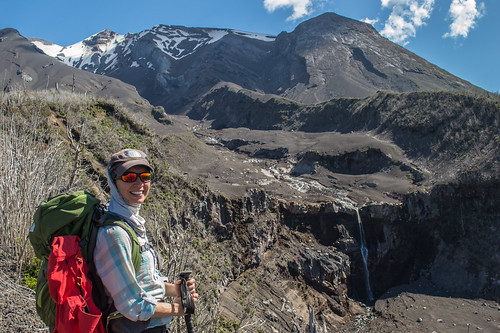Last year,
Volcán Calbuco in the Los Lagos Region of Chile (about 1000 km south of Santiago, near the city of Puerto Montt) erupted in a spectacular manner. 210 million cubic metres of crushed rock of different sizes were spit as "ash" into the atmosphere, then blown some distance by the wind, before being deposited on the surrounding land.
Fortunately, no (human) lives were lost on this occasion, but the ash that piled up to half a metre in some locations around the volcano (particularly around the village of Ensenada to the north-east) caused a lot of damage, crushing houses under its weight.
 |
| Calbuco in the background, photo taken during our Osorno climb at the end of 2014 |
Calbuco is one of the most active volcanoes of Chile, with more than a handful of eruptions during the 20th century, the last one in 1972. Its eruptions usually are of a somewhat explosive nature, often with huge amounts of ash involved, but relatively little lava, if any.
We didn't witness the 2015 eruption firsthand, and only about 6 months later had a chance to check out the damage (see our
post from back then). Since then, we have been to the area a couple of times, each time noticing how the clean-up progressed, people returning to their homes, new homes being built even closer to the volcano (!) and the ash-brown-grey landscape turning green again slowly.
Calbuco has also been on our "to climb list" for a while, so a few weeks ago decided to treat us to a weekend in the South. We reserved tickets for the Friday and Sunday overnight buses to and from Santiago. Saturday during the day we visited the
Saltos del Petrohue and afterwards had a quick dip in the
Lago Esmeralda. Following that we visited some friends that recently started keeping bees near Lago Rupanco (it was very interesting to see a bee colony working for the first time). The Saturday evening we went to a show in the
Teatro del Lago in nearby Frutillar (a trio of ballet, piano and orchestra - to mix a bit of culture into the mountaineering experience).
 |
| Saltos del Petrohue: White water and old lava flows |
 |
| Jack and Christian |
 |
| A dip with a view at Lago de todos los Santos |
On Sunday morning, we set off at 5am from our
hostel in nearby Puerto Varas and by 6am we hit the trail. The first couple of hours climb through what used to be lush Valdivian rain forest, which clearly suffered damage from the bombardment of rocks and the ash from the eruption (the marks from the falling rocks are still visibly etched on the bark of the trunks). In many places it seems very dead, see picture below.
 |
| View of nearby Osorno volcano, through the remnants of previously lush green rain forest |
Life is coming back, though, there are no doubts about it. The higher one climbs and the closer one gets to the volcano, the more spare these new signs of life still are, but they are there!
 |
| One of the survivors growing new leaves and branches |
 |
| "Chilean rhubarb" (gunnera tinctoria) pushing through the "ash/rubble" (in this place: volcanic pebble-sized rocks) |
Once above the tree line, at around 1000m above sea level, the climb steepens and it turns a bit into a "two-steps-up-and-one-back-down" type of slog. The "ash" that deposited here consists of pebble-sized rocks spit out during the eruption, which give way when stepping on them, making progress quite slow at times.
 |
| Above the tree line, Osorno and Puntiagudo at the back |
Much of the climb is fairly non-technical, though we did rope up in a couple of exposed places. Our guide José-Miguel of
Huella Andina (same as for our
Osorno climb) did a great job taking care of us. Once near the top, we went to check out the new crater from the eruption, i.e. the hole left behind by all the pulverized / crushed material that now covers much of the surrounding area. Quite cool was also to see how steam is still coming out of the ground near and inside the crater in a few places. We could also smell the sulfur gases coming from underground.
 |
| Steam escaping from the ground near the crater |
The actual summit of Calbuco (just over 2000m above sea level) is not exactly at the rim of the new crater, but rather forms part of a much bigger, older crater (within which the new crater is located) some distance away. To reach the peak, we had to climb some more and then rope up again and traverse across some icy bits, which was fairly exciting q-:
 |
| Exciting traverse just below the summit (not a good place to slip!) |
 |
| On the summit |
We were so lucky with the weather and could enjoy incredible views all along the climb up, from the top, and again on the way down - very much a bonus that one shouldn't take for granted when climbing this mountain! Some of those beautiful views and some other impressions are captured in below
slideshow.
In a nutshell, one of those "this-is-why-we-are-still-in-Chile-more-than-5-years-on" type of weekends!












No comments:
Post a Comment